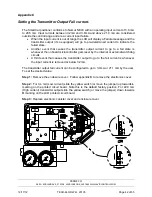
CRANE
CO.
280
N.
MIDLAND
AVE.,
STE
258,
SADDLE
BROOK,
NJ
07663
WWW.AVIDCONTROLS.COM
12/17/12
TECH-440/D.W.O. 23135
Page 27 of 55
energized (full travel) position (hard stop). The user will notice full pressure to
Outlet Port 1 and zero pressure to Outlet Port 2. At this point the user has the
option to either select the hard stop as the high (span) position, or to select an
arbitrary position as the high (span) position.
PID
The PID function allows the user to modify the PID settings of the positioner so
the user can optimize the dynamic response of the positioner
regarding the
speed of response, overshoot and
steady-state
error by varying the appropriate
gain settings. This function is often used to fine tune the PID values obtained
from the automatic calibration function (
ACAL
). The PID entry allows the user to
modify the tuning parameters in three different ways:
1.
Auto PID
: this option triggers the Auto PID procedure. It will override the
positioner control and will modulate the valve in order to automatically find out
the best P, I and D parameters.
2.
Manual PID
: the
Manual
Proportional (PCAL)
and
Derivative (DCAL)
gain settings can be varied incrementally on a scale from 1-20. The
Integral
(ICAL)
gain setting can be varied incrementally on a scale from 1-5. The Manual
PID values are actually index representations of the Fine Tune settings that are
reported through the HART communication.
3.
Fine Tuning: t
he
Fine Tune
Proportional (PCAL)
,
Derivative (DCAL)
and
Integral (ICAL)
gain settings can be varied incrementally on a scale from 1-255.
The fine tuning values are directly related to the actual time constant values (Ti
or Td) and the Proportional gain value (Kc). The proportional gain (Kc) has a
direct effect in the system response time. So, as higher the Kc as faster is the
response time. The drawback of increasing the value of the Kc is the higher
overshoot and settling time. Sometimes the valve’s position control becomes
instable, oscillating forever around the set point. The integrative term (Ti) affect
the dynamic response of the position control by damping the positioner response
according to the Ti value. So as lower the value of Ti as less damped is the
dynamic response. This means that as lower the Ti as more oscillations are
observed before the stabilization of the position and vice-versa. However, as
higher the Ti as higher will be the settling time. Regarding the Derivative term
(Td), as greater is its value as greater will be the derivative effect. Different from
the proportional gain and integrative term, the derivative term is not proportional
to the error but the variation of the position. The effect of Td is to decrease the
overshoot and the control reacts against the variation of the position. The
drawback is that as higher the Td as unstable can be the control system.
Snsr
The sensor calibration is a self-adjustment that sets the positioner’s Hall-Effect
circuitry. This is automatically done during the
ACAL (Automatic Calibration)
routine. The sensor calibration also shows up under the
MCAL
menu. This
calibration only needs to be performed under the
MCAL
routine when the
































